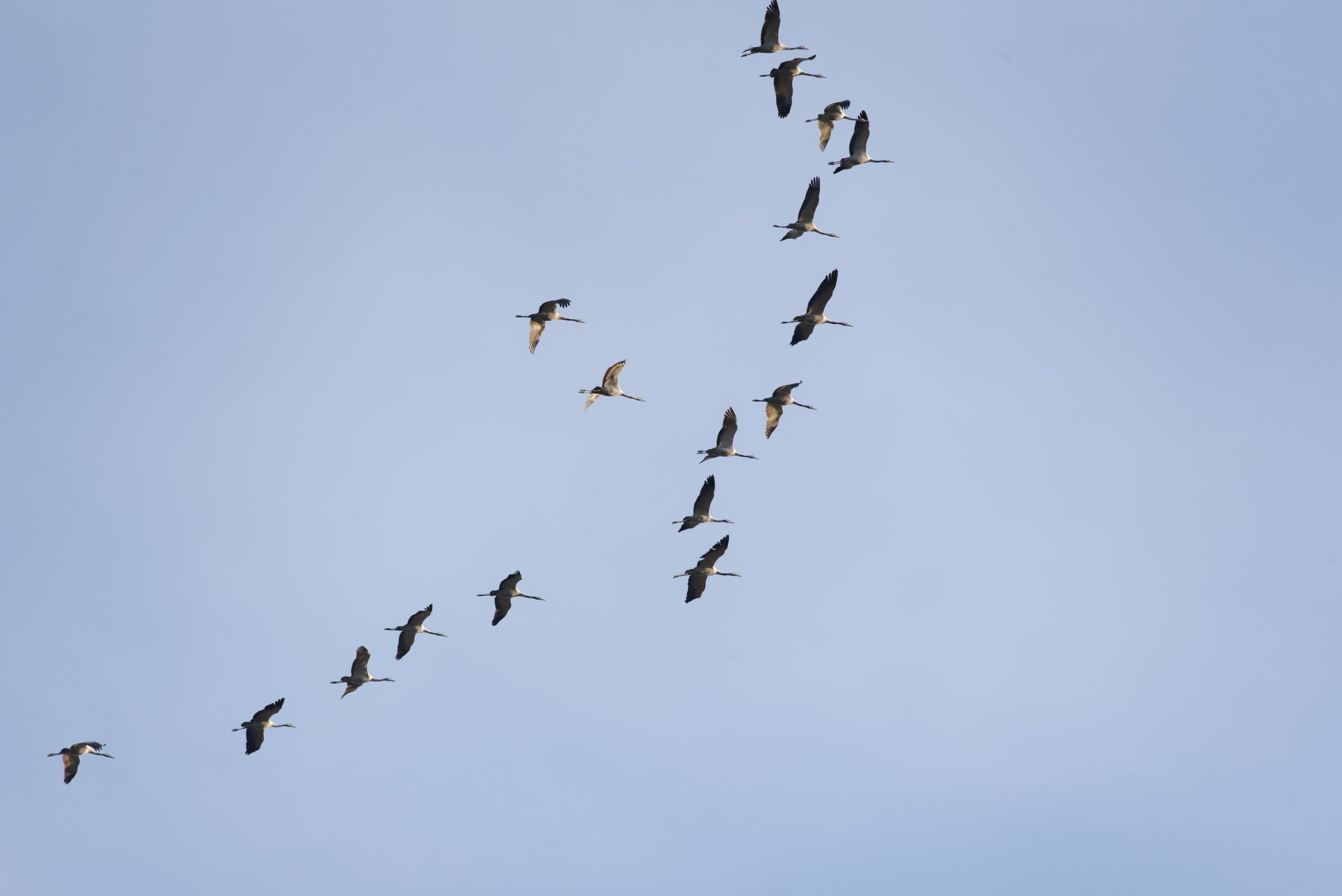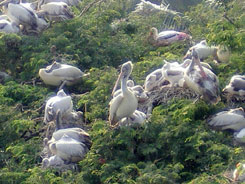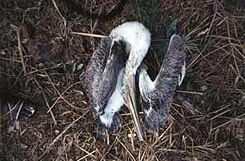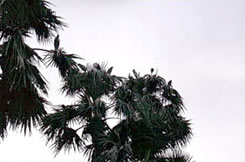
VSPCA migratory bird protection project
Beside the Bay of Bengal, there is an area in the Srikakulam District of Andhra Pradesh known as Nowpada famous for its salt lands. Both Telinelipuram and Telikunchi are nearby. The area for the migratory birds is 7,000 acres and includes a former salt factory 4 km from Telinelipuram. Tamarind and Mesquite trees grow here.
Over 40 different bird species make this refuge their home. It is an extraordinary gathering of Migratory Birds who also gather here including the Spot-Billed Pelicans, Painted Storks, Adjuvants (a type of Stork), Black Ducks and others. On the beach, we find the nesting grounds of the endangered Sea Turtle.

Pelicans – Migratory Birds in Telinelipuram 120 kilometres from Visakhapatnam is a favourite place for poaching these migratory birds. VSPCA has begun protecting these birds against poaching along with the Forest Department since August 2000. |

Painted Storks – in direct peril of the poachers at Telinelipuram. Started protection since August 2000. |

A Migratory bird did to death by the poachers at Telikunchi. |

One of the VSPCA volunteers rescues a baby Pelican at Telikunchi. |

Trees stripped of leaves |

Birds in palm trees |
| Migratory birds in serious danger of losing their habitats where the trees have lost their leaves and thus due to lack of trees these birds are perching on palm trees while simultaneously losing their young ones which fall down dead. This is at Punyakshetram, Rajahmundry. | |
HISTORICAL BACKGROUND
These birds are thought to have migrated originally from the Great Russian ice desert in Siberia. They went south towards Asia, seeking warmer and more comfortable places in the world like India, Sri Lanka, Andamans, Thailand, and Malaysia. However, they seemed especially drawn to the Indian Peninsula.
They come to breed in and around large bodies of water and coastal areas. Visiting large bodies of water in Andhra Pradesh like Kolleru Lake in the East and West Godavari Districts and in the Pulicat and Nelapatu Sanctuaries in the Nellore District of Andhra Pradesh. They also visit the Pudimedaka and Kondakaria areas of the Visakhapatnam District. The birds visiting the Telinelipuram and Telikunchi villages in the Srikakulam District have been expanding their breeding grounds into new territory.
The Srikakulam District holds a distinct and unique attraction for these migratory birds, right from Itchapuram to Kandivalasa Gadda. Painted Storks also frequent Etcheria and Manikyapuram near Sompeta, because of the presence of big, suitable bodies of water, riparian networks, and enough nesting places. The tanks near the shore planted with Babul attract birds to nest.
APPRECIATION
For hundreds of years, Migratory Birds have been coming to these villages in great abundance and in return, the villagers appreciate them. The surrounding feeding places, safety from human interference, and the many trees have all drawn huge numbers of birds. Every year nearly 1,500 Pelicans and 2,000 Painted Storks migrate to this area and may leave when their babies grow up with their numbers increased. While the Migratory Bird season of Telinelipuram runs from August to March, that of Telikunchi runs from May to October.
THREATS
There is very heavy poaching by local people that tends to be organized by vested interests for consumption. The birds fetch Rs. 200/- to Rs. 500/- per bird depending on the size. They are caught in the most pathetic way from primitive weapons to the use of nets. The traps are laid in the evening and in the early morning, the hunters go and fetch their catch. These birds are trapped by netting, using nylon nets in the feeding grounds. Poachers from Santhabommali Mandal and from about 15 villages use mainly the spreading of nets to trap the birds. These trapped birds are sold clandestinely in the villages. People also poach by guns.
There are no trained protection agents provided by the Forest Department. In any case, the Police and the Forest Department Office are 70 km away, too far for prompt action, and there is no coordination or communication. The existing trees are diminishing, and no new trees are being planted, making the future very bleak for these Migratory Birds.
OUR EFFORTS
Since 2000 we have been interacting with the Forest Department of Srikakulam for the necessary protection of these birds and to begin to create awareness, as well as establishing the essential conditions for the birds to be able to arrive and feel safe.
An individual has been acting on our behalf to coordinate this program with the authorities. Since our protection efforts have begun the poachings are down considerably and the bird population is increasing.
PURPOSE OF THE PROJECT
To stop the thoughtless poaching that is fast depleting the bird population – by local participation, involving the villagers, the authorities and NGOs — with an emphasis on villagers being actively engaged in protecting the natural habitat around them.
As we explore and widen our scope with the goal of saving all kinds of animals and preventing harm and abuse to them, we come across many valuable wetlands that are still unprotected. These areas need urgent help to stop the illegal trading and poaching that threaten the very existence of the habitats.
WHAT WE WOULD LIKE TO ACCOMPLISH IN THE FUTURE
Our Strategy
- By involving the community we aim to instil respect and appreciation among the villagers towards the birds by conducting awareness and education programs and they will in turn help to provide permanent, safe habitats for the birds. We will form a task force including the village representative, like-minded NGOs, the Forest Department, the Revenue Department and the Police to carry out the field protection. And have at least two persons, trained in wildlife rehabilitation, to take care of the birds and the hatchlings due to unforeseen circumstances leading to injuries and fallen hatchlings
- By enhancing the special bond between birds and people, we aim to look after the basic needs of the village by providing free medical assistance, primary education, and other general help and advice as a confidence-building measure for this project,
- By planting trees specifically for the birds to roost in, such as the tamarind and peepal as these are the most attractive trees for the birds to roost in. This is urgent as the current habitat is deteriorating. By providing abundant supplementary trees and a comprehensive education campaign in all the nine area villages we will encourage the appreciation of the ten thousand acres wetland where most of the poaching takes place.
- To have volunteers as well as paid staff to prevent poaching and to rehabilitate injured birds that may be attacked as they are feeding in the wetlands. They can place nets under the trees and nests to prevent the chicks from falling to the ground and interact with the Forest Department and experts to take care of any of ones who do fall and rescue and rehabilitate them,
- These dwindling wetland habitats are highly susceptible to poaching and to natural disasters. We will lobby for this important home for the Pelicans and Storks to be officially declared a protected area. We will make substantial progress in all these areas mentioned above operating under this special protection which is based on the importance of the many Indian species and the arrival and presence of non-native species.
CONCLUSION
Environment once lost cannot be regained at any cost. Natural habitat has to be maintained in its original state in order to attract these birds. There are many areas that, due to overuse and the interference of humans, have degenerated as wildlife habitat, causing birds to stop visiting Kolleru Lake (a big body of water in the Krishna and West Godavari Districts of Andhra Pradesh) and the Pulicate River.
Since 2000 we have come a long way and have made a real difference in lessening the hardships that these birds face. However, much effort is still needed to ensure that these wetlands are given protected status, on a permanent basis. We appeal to you for your kind generosity that will allow our objectives to become a reality.
For a one year project:
- Rs. 20000 (USD 434.00) could sponsor our awareness and education campaign in the area. This includes brochures printed in the local language and their distribution in nine surrounding villages.
- Rs. 30000 (USD 652.00) additional is needed for the fuel charges for the trips for VSPCA to visit and monitor the progress in the area
- Rs. 28000 (USD 608.00) to pay the wages for four field protectors
- Rs. 42000 (USD 913.00) to pay for special bird feed
- Rs. 37000 (USD 804.00) would pay for medicine to treat the fallen chicks
Your kind contribution would go to a fund specifically sent up for this project. Please make your cheque out to “VSPCA” for the Migratory Birds – or donate online – and consider supporting any part of this vital project.
